You searched for: world war I
<< Previous | Displaying results 26-50 of 533 for "world war I" | Next >>
-
German retreat during World War I
PhotoBritish troops at the site of a former German trench following the withdrawal of German troops to the Hindenburg line on the western front in World War I. This photograph shows a trench bridge over a German trench. Gommecourt, France, 1917.
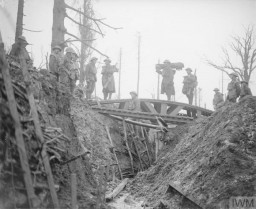
-
British soldiers in a trench during World War I
PhotoBritish troops in a trench cover the bodies of two fellow soldiers killed during the Battle of the Somme, November 1916. © IWM (Q 4393)
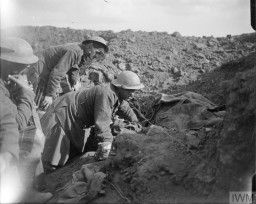
-
US soldiers during World War I
PhotoSurrounded by destruction, US soldiers of the 23rd Infantry fire a gun during World War I, 1918.
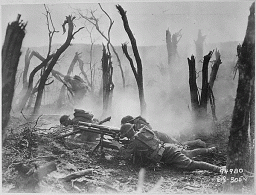
-
World War I US Army field hospital
PhotoA US army field hospital inside the ruins of a church in France during World War I. France, 1918
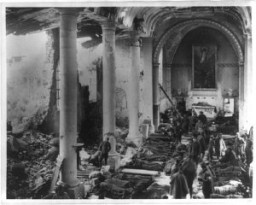
-
Scene of destruction during World War I
PhotoScene of destruction during World War I: panoramic view of the battlefield at Guillemont, September 1916, during the Battle of the Somme. © IWM (Q 1281)

-
World War II: In Depth
ArticleGermany started World War II in Europe on September 1, 1939, by invading Poland. War would continue until 1945. Learn more about key events in the history of WWII.
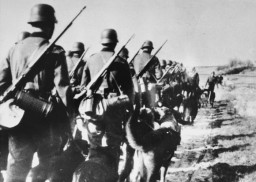
-
World War II in Europe
ArticleGermany started World War II in Europe on September 1, 1939, by invading Poland. War would continue until 1945. Learn more about WWII and genocide in Europe.
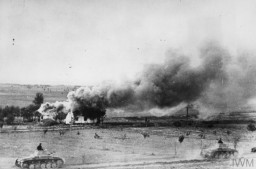
-
Trench warfare on the western front during World War I
PhotoTrench warfare is one of the iconic symbols of World War I. This photograph shows British troops carrying boards over a support line trench at night during fighting on the western front. Cambrai, France, January 12, 1917.
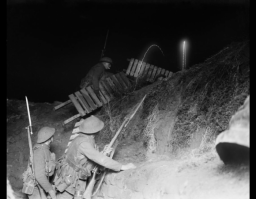
-
Adolf Hitler was a frontline soldier during World War I
PhotoAdolf Hitler (front row, far left) served on the western front in World War I and during the course of the war was twice decorated for service, wounded, and temporarily blinded in a mustard gas attack. He used his veteran status in later election campaigns.
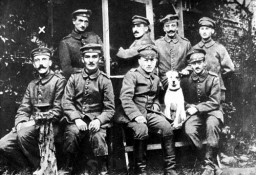
-
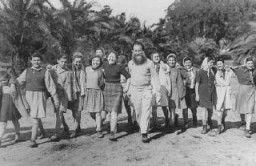
-
US enters World War II
FilmPortion of the speech in which President Franklin D. Roosevelt asked the US Congress to declare war on Japan following the previous day's surprise attack on Pearl Harbor.
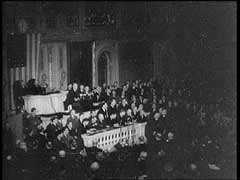
-
The German Army and the Racial Nature of the War against the Soviet Union
ArticleNazi Germany invaded the Soviet Union in 1941. Learn more about the racial and ideological motivations behind this “war of annihilation.”
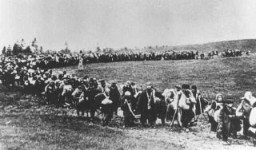
-
John Komski describes Krakow after the outbreak of World War II
Oral HistoryJohn, who was born to a non-Jewish Polish family, graduated from an art academy. Following the German invasion of Poland on September 1, 1939, John was in Krakow. Food became scarce in Krakow, with long lines of people waiting for whatever food was available. John decided to join the resistance against the Germans. By early 1940, he and two of his friends felt that they were in danger and decided to try to escape to France. John was caught and arrested during this escape attempt. He survived imprisonment…
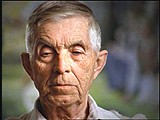
-
Photograph of Kitty Weichherz taken before World War II
PhotoKitty Weichherz, pictured here in a photograph taken before World War II began, was born in December 1929. This photo was taken from a diary of Kitty's life written by her father, Bela Weichherz. After Kitty's birth, Bela started to keep a diary of his daughter's life. He made entries recording her childhood in Czechoslovakia until the family was separated and deported during the Holocaust. His last entry reads "I only wish that we can go together." Kitty and all of her immediate family perished in the…
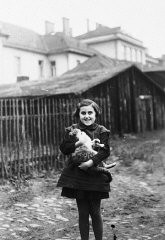
-
War Refugee Board: Background and Establishment
ArticleIn January 1944, FDR established the War Refugee Board which was charged with “immediate rescue and relief of the Jews of Europe and other victims of enemy persecution.”
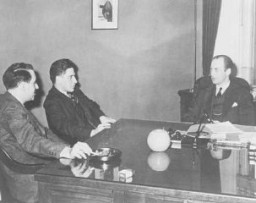
-
The 89th Infantry Division during World War II
ArticleThe 89th Infantry Division participated in major WWII campaigns and is recognized for liberating the Ohrdruf subcamp of Buchenwald in 1945.
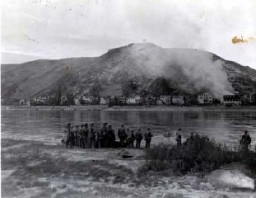
-
The 86th Infantry Division during World War II
ArticleThe 86th Infantry Division participated in major WWII campaigns and is recognized for liberating Attendorn, a civilian forced-labor camp, in 1945.
-
The 29th Infantry Division during World War II
ArticleThe 29th Infantry Division participated in major WWII campaigns and is recognized for liberating Dinslaken, a civilian labor camp, in 1945.
-
The 4th Infantry Division during World War II
ArticleThe 4th Infantry Division participated in major WWII campaigns and is recognized for liberating the Haunstetten subcamp of Dachau.
-
The 1st Infantry Division during World War II
ArticleThe 1st Infantry Division participated in major WWII campaigns and is recognized for liberating two subcamps of Flossenbürg in 1945.
-
The 26th Infantry Division during World War II
ArticleThe 26th Infantry Division participated in major WWII campaigns and is recognized for liberating the Gusen subcamp of Mauthausen in 1945.
-
The 36th Infantry Division during World War II
ArticleThe 36th Infantry Division participated in major WWII campaigns and is recognized for liberating some of the Kaufering subcamps of Dachau in 1945.
-
The 90th Infantry Division during World War II
ArticleThe 90th Infantry Division participated in major WWII campaigns and is recognized for liberating the Flossenbürg concentration camp in 1945.
-
The 83rd Infantry Division during World War II
ArticleThe 83rd Infantry Division participated in major WWII campaigns and is recognized for liberating the Langenstein subcamp of Buchenwald in 1945.
-
The 2nd Infantry Division during World War II
ArticleThe 2nd Infantry Division participated in major WWII campaigns and is recognized for liberating Leipzig-Schönefeld and Spergau/Zöschen in 1945.
